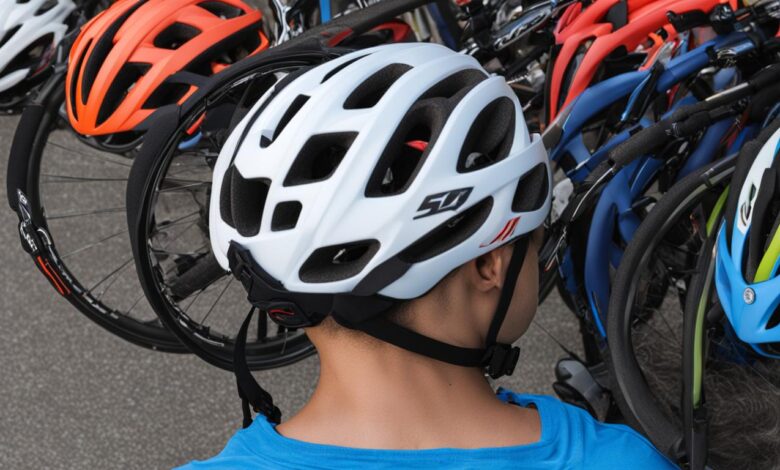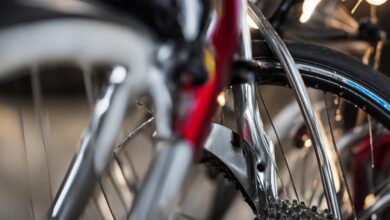Bike Helmet Fit and Care: Essential Tips

Properly fitting and caring for your bike helmet is essential for ensuring your safety while cycling. In this article, we will explore the importance of bike helmet fit and care, discuss how to choose the right bike helmet, and provide helpful tips for adjusting and maintaining your helmet.
Key Takeaways:
- Choosing the right size helmet based on your head circumference is the first step in ensuring proper fit.
- A properly fitted helmet should sit level on the top of your head, with only a small sliver of forehead exposed.
- Regularly inspect your helmet for any signs of damage or wear and replace it if necessary.
- Proper care and maintenance, such as cleaning with mild soap and water, prolongs the lifespan of your helmet.
- Avoid common mistakes in helmet fit, such as wearing the helmet too far back or attaching protruding objects to it.
Why Proper Helmet Fit is Important
Wearing a helmet properly is vital for unlocking its safety benefits. A properly fitted helmet should sit level on the top of your head, with only a small sliver of forehead exposed. It should sit squarely and snugly, without any excessive movement when you shake your head. Proper helmet fit is essential for reducing the risk of head injuries and ensuring optimal protection during an accident.
Here are some helmet safety tips and troubleshooting techniques to help you achieve the perfect fit:
- Start with the right helmet size for your head shape. Different head shapes may require different helmet designs for a proper fit.
- Measure your head circumference using a fabric tape measure to determine the correct helmet size.
- Ensure that the helmet sits level on your head, covering the top part evenly without tilting forward or backward.
- Adjust the helmet straps to achieve a snug and secure fit. The chin strap should be comfortably snug under your chin.
- Check for any excessive movement of the helmet when you shake your head. A properly fitted helmet should stay in place.
Remember, helmet fit can vary depending on head shape, so troubleshoot any discomfort or fit issues by trying different helmet models and sizes until you find the one that provides the best fit and protection.
“Properly fitted helmets can significantly reduce the risk of head injuries during accidents.” – Dr. Sarah Davis
By following these helmet fit tips and troubleshooting techniques, you can ensure that your helmet provides optimal protection, regardless of your head shape or cycling discipline.
| Head Shape | Recommended Helmet Type |
|---|---|
| Oval | Most helmet designs cater to oval head shapes. |
| Round | Look for helmets with adjustable fitting systems for a secure fit. |
| Long | Choose helmets with extended rear coverage for added protection. |
| Narrow | Opt for helmets with adjustable straps for a customized fit. |
How to Choose the Right Size Helmet
Choosing the right size helmet is crucial for a proper fit. Most helmets come in a range of sizes determined by head circumference, typically ranging from 50 to 60cm. To determine your size, use a fabric tape measure to measure around your head just above your ears and brow. Trying on a helmet before buying is recommended to ensure a comfortable fit.
When measuring your head, make sure the tape measure is snug but not too tight. Take note of the measurement and refer to the manufacturer’s sizing chart to find the appropriate helmet size. It’s important to note that different helmet brands may have slightly different sizing, so always refer to the specific brand’s guidelines.
Aside from measuring head circumference, it’s also important to consider different head shapes. Not all helmet shapes are suitable for every head shape, so it’s important to try on different helmets to find the one that suits your shape best. Some common head shapes include:
- Oval head shape: Narrow from front to back and wider from side to side.
- Round head shape: Evenly proportional in all directions.
- Elongated head shape: Longer from front to back and narrower from side to side.
It’s recommended to visit a local bike shop and try on helmets from different brands to find the best fit for your head shape. An experienced salesperson can provide guidance and help you find the perfect helmet size and shape. Remember, a well-fitting helmet should feel snug but not uncomfortable, with no excessive pressure points or gaps that could affect its protective capabilities.
Tips for Choosing the Right Helmet Size:
- Measure your head circumference just above your ears and brow using a fabric tape measure.
- Refer to the manufacturer’s sizing chart to find the appropriate size.
- Consider trying on helmets from different brands to find the best fit for your head shape.
- Ensure the helmet feels snug but comfortable, with no excessive pressure points or gaps.
- Seek assistance from a knowledgeable salesperson at a local bike shop for expert advice.
Remember, choosing the right size helmet is essential for your safety and comfort while cycling. Take the time to find the perfect fit and enjoy your rides with confidence.
Tips for Adjusting Helmet Fit
Once you have chosen the correct size helmet, it’s crucial to fine-tune the fit for optimal comfort and safety. Here are some essential techniques for adjusting your helmet:
- Loosen before wearing: Before putting on your helmet, make sure to loosen any securing systems such as the ratchet or dial adjustment.
- Position the helmet: Adjust the front of the helmet so that it sits one to two finger-widths above your brow. This position ensures proper protection for your forehead.
- Tighten the helmet: Use the ratchet system or other available mechanisms to tighten the helmet around the circumference of your head. Ensure a snug fit without causing discomfort or pressure points.
- Secure the chin strap: Fasten the chin strap securely under your chin, making sure it is snug but not overly tight. The strap should allow you to breathe comfortably and not restrict your movement.
- Adjust the side straps: Check the side straps and adjust them so that they meet just under your earlobes. The straps should form a V-shape around your ears, providing stability and preventing the helmet from shifting during a ride.
- Regularly check and adjust: It’s important to regularly check the fit of your helmet, especially before each ride. Make any necessary adjustments to ensure a secure and comfortable fit.
By following these helmet adjustment techniques, you can ensure that your helmet provides the best possible protection and fits properly throughout your cycling adventures.
Helmet Fit Troubleshooting:
If you’re experiencing any issues with helmet fit, here are some troubleshooting tips to consider:
- Helmet feels loose: If your helmet feels loose or moves excessively when you shake your head, try adjusting the fit system or consider a smaller size.
- Helmet feels tight or uncomfortable: If your helmet feels too tight or uncomfortable, adjust the fit system or consider a larger size.
- Helmet sits too high or low: Ensure the helmet sits level on your head, with the front positioned one to two finger-widths above your brow.
If you’re unable to achieve a comfortable and secure fit, it may be necessary to try a different helmet model or consult a knowledgeable bike shop for assistance.
Common Mistakes in Helmet Fit
When it comes to helmet fit, avoiding common mistakes is crucial for your safety on the road. By understanding and addressing these mistakes, you can ensure that your helmet fits properly, providing optimal protection during your cycling adventures.
Avoid wearing your helmet too far back on your head or too low on your forehead. The ideal helmet position is level on the top of your head, with just a small sliver of forehead exposed. This ensures that the helmet covers the most vulnerable areas and offers maximum protection.
Never wear a hat underneath your helmet, as it can affect the fit. Hats can create additional padding and alter the helmet’s position, compromising its protective capabilities. It’s important to wear only the helmet, allowing it to fit snugly and securely on your head.
Do not attach any protruding objects to your helmet, such as accessories or gadgets. These objects can create stress points on the helmet, making it more susceptible to damage or failure during a crash. Additionally, they can pose a risk of snagging on objects, further increasing the potential for injury.
Always ensure that you wear your helmet with the front facing forward. In the event of an accident, the design and structure of the helmet are optimized for the front-facing position, providing the highest level of protection.
By avoiding these common mistakes, you can ensure that your helmet fits properly and offers the best possible protection while cycling.
Common Helmet Fit Mistakes and Solutions
| Mistake | Solution |
|---|---|
| Wearing the helmet too far back on the head | Position the helmet level on the top of the head, with a small sliver of forehead exposed |
| Wearing the helmet too low on the forehead | Adjust the helmet to sit securely on the head, covering the most vulnerable areas |
| Wearing a hat underneath the helmet | Wear only the helmet to maintain a proper fit without interference from additional padding |
| Attaching protruding objects to the helmet | Avoid attaching accessories or gadgets to prevent stress points and potential injury |
| Wearing the helmet with the back facing forward | Always wear the helmet with the front facing forward for optimal protection |
Helmet Maintenance and Care
Taking care of your helmet is essential for maintaining its effectiveness and prolonging its lifespan. By regularly inspecting, handling, storing, and cleaning your helmet, you can ensure that it continues to provide optimal protection every time you ride.
Inspect for Damage
Before every ride, it’s important to inspect your helmet for any signs of damage. Look for cracks, dents, or wear on the shell, as well as fraying or weakening of the straps. If you notice any damage, it’s crucial to replace your helmet to maintain its integrity.
“Regularly inspecting your helmet for damage is a key part of proper helmet care.”
Handle with Care
Avoid unnecessary impacts that could weaken your helmet’s structure by handling it with care. Don’t throw or drop your helmet, and avoid storing heavy objects on top of it. Treat your helmet as if it were protecting your head at all times.
Store in Optimal Conditions
Proper storage is vital for maintaining your helmet’s condition. Store it in a cool and dry place, away from extreme temperatures and direct sunlight. Heat can affect the helmet’s integrity, so avoid leaving it in the car or exposed to the sun for long periods.
Clean Regularly
To keep your helmet fresh and hygienic, clean it regularly using mild soap and water. Avoid using harsh chemicals that can damage the materials. Gently scrub the shell, foam, and interior padding, and rinse thoroughly. Allow your helmet to air dry completely before using or storing it.
Protective Case
Consider investing in a protective case or bag for your helmet. This will help prevent unnecessary damage during transportation or storage, ensuring your helmet remains in top condition.
Helmet Maintenance Tips:
- Regularly inspect your helmet for any signs of damage.
- Handle your helmet with care to avoid unnecessary impacts.
- Store your helmet in a cool and dry place, away from extreme temperatures and direct sunlight.
- Clean your helmet regularly using mild soap and water.
- Consider using a protective case or bag for transportation or storage.
By following these helmet maintenance tips, you can ensure that your helmet stays in excellent condition, ready to provide the protection you need on every ride.
Protecting Your Helmet from Damage
Proper helmet care is crucial for maximizing its effectiveness and ensuring your safety while cycling. In addition to regular maintenance and cleaning, it’s important to take steps to protect your helmet from unnecessary damage. By following these helmet safety tips, you can prolong the lifespan of your helmet and maintain its structural integrity.
Avoid Dropping or Throwing Your Helmet
Helmets are designed to withstand impact, but unnecessary drops or throws can weaken their structure. Always handle your helmet with care and avoid any actions that could cause it to fall or collide with hard surfaces. Even a minor impact can compromise its protective capabilities.
Invest in a Helmet Case or Use Proper Storage
To provide additional protection during transportation or storage, consider investing in a helmet case. A quality case will safeguard your helmet from accidental impacts, dust, and other potential hazards. If a case is not available, you can wrap your helmet in a soft shirt or cloth to provide cushioning and minimize the risk of damage.
Avoid Exposing Your Helmet to Extreme Heat
High temperatures can have adverse effects on your helmet’s structural integrity. Avoid leaving your helmet in places where it could be exposed to extreme heat, such as inside a hot car or in direct sunlight for an extended period. Excessive heat can melt the glue that holds the helmet’s components together, compromising its overall strength and protection.
Avoid Exposure to Spray Paints and Solvents
Spray paints and solvents contain chemicals that can degrade the materials used in your helmet. Avoid spraying any painting or cleaning substances near your helmet and store it in a location where it won’t be exposed to any fumes. By preventing contact with these substances, you can ensure the longevity and effectiveness of your helmet.
| Tips to Protect Your Helmet |
|---|
| Avoid dropping or throwing your helmet |
| Invest in a helmet case or use proper storage |
| Avoid exposing your helmet to extreme heat |
| Avoid exposure to spray paints and solvents |
By following these tips, you can protect your helmet from unnecessary damage and ensure its continued ability to provide the safety and protection you need during your cycling adventures.
Proper Storage for Your Helmet
Proper storage is an important aspect of helmet care and maintenance. By storing your helmet correctly, you can ensure its structural integrity and prolong its lifespan. Here are some helmet safety tips for proper storage:
- Find a cool and dry place: Choose a storage location that is away from direct sunlight and extreme temperatures. Heat and sunlight can cause the helmet’s materials to degrade over time.
- Avoid hanging the helmet: Hanging your helmet on a hook or other precarious positions can increase the risk of falling and unnecessary impacts. Instead, opt for a more secure storage option such as a helmet bag or shelf.
- Protect from external damage: Keep your helmet away from other objects that may cause damage, such as sharp edges, heavy items, or chemicals. Avoid storing it near solvents or spray paints that can degrade the materials.
Proper storage for your helmet not only prevents accidental damage that may affect its performance but also ensures that it is ready for use whenever you need it.
| Proper Storage Tips | Benefits |
|---|---|
| Find a cool and dry place | Preserves the integrity of the helmet’s materials |
| Avoid hanging the helmet | Prevents accidental falls and unnecessary impacts |
| Protect from external damage | Ensures the helmet remains in optimal condition for use |
Cleaning Your Helmet
Regular cleaning is necessary to keep your helmet in good condition. Proper helmet care not only ensures its longevity but also enhances its effectiveness in protecting your head during rides. Follow the steps below to clean your helmet:
Gather the Materials
- Mild soap: Choose a gentle soap that won’t damage the materials of your helmet.
- Water: Use clean water at room temperature for rinsing.
- Soft cloth or sponge: Opt for a non-abrasive cloth or sponge that won’t scratch the surface of your helmet.
Cleaning the Outer Shell
- Fill a basin or sink with lukewarm water and add a small amount of mild soap. Mix well to create a soapy solution.
- Dip the soft cloth or sponge into the soapy solution, ensuring it is damp but not saturated.
- Gently scrub the outer shell of your helmet, paying attention to areas with dirt, sweat, or debris buildup.
- Rinse the outer shell thoroughly with clean water, ensuring all the soap is removed.
- Pat dry the outer shell with a clean towel to remove excess moisture. Avoid using a direct heat source to dry your helmet.
Cleaning the Foam and Interior Padding
- Check the manufacturer’s instructions for your specific helmet regarding the removal of padding.
- If the padding is removable, carefully detach it according to the instructions.
- Wash the padding separately using mild soap and water. Gently scrub away any dirt or sweat.
- Rinse the padding thoroughly and allow it to air dry completely before reattaching.
- If the padding is not removable, use a damp cloth or sponge to gently clean the foam and interior padding.
- Rinse the cloth or sponge and remove any excess soap residue from the foam and padding.
- Air dry the helmet and padding completely before reassembling.
By cleaning your helmet regularly, you remove dirt, sweat, and debris that can compromise its functionality and hygiene. Avoid using harsh chemicals or solvents that may damage the materials. When in doubt, always refer to the manufacturer’s instructions for your specific helmet model.
A clean helmet not only offers a better cycling experience but also ensures your safety on the road. Take the time to clean and maintain your helmet properly for optimal performance and longevity.
Lice Prevention for Helmets
If you’re concerned about lice infestation in helmets, it’s important to take proactive measures for prevention. Using sprays is not recommended, as they may not effectively eliminate lice and can potentially damage the helmet materials. Instead, follow these steps to prevent lice infestations:
- Place the helmet in an airtight plastic bag for 48 hours. This will suffocate any lice or eggs present.
- After 48 hours, carefully remove the helmet from the plastic bag.
- Clean the surface of the helmet with warm water and mild soap. Gently scrub to ensure thorough cleaning.
- Pay special attention to the helmet’s padding and straps, as lice eggs may be attached to these areas.
- Discard the used pads to eliminate any potential lice or eggs that may have attached to them.
- Request replacement pads from the helmet manufacturer to ensure optimal hygiene.
Regularly cleaning and maintaining your helmet is key to preventing lice infestations. By following these steps, you can ensure that your helmet remains clean and free from lice, providing an added layer of protection during your cycling adventures.
When to Replace Your Helmet
Regularly inspecting and maintaining your bike helmet is essential for its long-term effectiveness in protecting your head. Knowing when to replace your helmet is crucial for ensuring optimal safety. Here are some key indicators that it’s time for a replacement:
- Visible Damage: Check for any cracks, dents, or fading on the outer shell of your helmet. These signs of damage indicate that the structural integrity of the helmet may be compromised.
- Strap Damage: Inspect the straps of your helmet. Look for signs of fraying, stretching, or excessive wear. Damaged straps can fail to provide adequate stability and compromise the fit of your helmet.
- Age: Even if your helmet shows no visible signs of damage, it’s recommended to replace it after three years of use. Over time, the materials and protective capabilities of the helmet can deteriorate.
If you notice any of these signs, it’s important to replace your helmet to ensure continued protection. Remember, it’s always better to err on the side of caution when it comes to your safety. Neglecting a damaged or worn-out helmet can significantly reduce its ability to protect you in the event of an accident.
Investing in a new helmet will give you peace of mind and ensure your ongoing safety as you enjoy your cycling adventures. Proper helmet maintenance and regular inspections are essential in ensuring that your helmet remains in optimal condition and provides the necessary protection when you need it the most.
Signs It’s Time to Replace Your Helmet
| Indicator | Description |
|---|---|
| Visible Damage | Cracks, dents, or fading on the outer shell |
| Strap Damage | Fraying, stretching, or excessive wear on the straps |
| Age | Three years of use, even without visible damage |

Conclusion
In conclusion, ensuring a proper fit and taking care of your bike helmet is of utmost importance for your safety while cycling. By following the necessary steps like choosing the right size helmet, adjusting it correctly, and avoiding common fit mistakes, you can enhance your protection on the road. Additionally, regular maintenance and cleaning, along with protecting your helmet from damage, will contribute to its longevity and effectiveness.
Remember, your bike helmet is your primary defense against head injuries, so it’s vital to prioritize its fit and care. By adopting these practices for bike helmet fit and care, you can enjoy your cycling adventures with peace of mind, knowing that you have taken important steps to protect yourself.
Stay safe, ride responsibly, and always wear a properly fitted and well-maintained helmet!
FAQ
Why is proper helmet fit important?
Proper helmet fit is important because it ensures optimal protection against head injuries. A properly fitted helmet can reduce the risk of head injury by up to 50%. It also ensures that the helmet sits securely on your head without excessive movement, maximizing its effectiveness in case of an accident.
How do I choose the right size helmet?
Choosing the right size helmet is crucial for a proper fit. To determine your size, measure the circumference of your head just above your ears and brow using a fabric tape measure. Most helmets come in a range of sizes, typically ranging from 50 to 60cm. Trying on a helmet before buying is recommended to ensure a comfortable fit.
How do I adjust the fit of my helmet?
To adjust the fit of your helmet, loosen any securing systems before putting it on. Adjust the front of the helmet so that it sits one to two finger-widths above your brow. Use the ratchet system to tighten the helmet around the circumference of your head, ensuring a snug fit without discomfort. Secure the chin strap under your chin and adjust the side straps to meet just under your earlobes. Regularly check and adjust the fit as needed.
What are some common mistakes in helmet fit?
Some common mistakes in helmet fit include wearing the helmet too far back on your head, wearing a hat that affects the helmet’s fit, and attaching protruding objects to the helmet. It’s important to ensure that the helmet actually fits you and doesn’t sit too high or too low on your head. Always wear your helmet with the front facing forward.
How do I maintain and care for my helmet?
To maintain and care for your helmet, regularly inspect it for signs of damage, such as cracks, dents, or wear on the straps. Handle your helmet with care to avoid unnecessary impacts. Store your helmet in a cool and dry place, away from extreme temperatures and direct sunlight. Clean your helmet regularly using mild soap and water, avoiding harsh chemicals that can damage the materials.
How can I protect my helmet from damage?
To protect your helmet from damage, avoid dropping or throwing it. Consider investing in a helmet case or at least wrapping it in a shirt when traveling. Protect your helmet from extreme heat, as high temperatures can melt the glue that holds it together. Avoid exposure to spray paints and solvents, as they can degrade the helmet’s materials.
How should I store my helmet?
Proper storage is important for maintaining the structural integrity of your helmet. Find a cool and dry place to store your helmet, away from direct sunlight and extreme temperatures. Avoid hanging your helmet where it may fall or be prone to unnecessary impacts. Instead, use a secure location such as a helmet bag, shelf, or helmet hook.
How do I clean my helmet?
Regular cleaning is necessary to keep your helmet in good condition. Use mild soap and water to clean the outer shell, foam, and interior padding of your helmet. Gently scrub away dirt, sweat, and debris, and rinse thoroughly. Avoid using harsh chemicals or solvents that can degrade the materials. For removable padding, follow the manufacturer’s instructions on washing and drying. Allow the helmet and padding to air dry completely before reattaching.
How can I prevent lice infestations in my helmet?
If you are concerned about lice infestation, do not use sprays. Instead, place the helmet in an airtight plastic bag for 48 hours, then clean the surface with warm water and mild soap. Discard the used pads and request replacement pads from the manufacturer. Regularly cleaning and maintaining your helmet can help prevent lice infestations.
When should I replace my helmet?
Regularly inspect your helmet for signs of damage or wear. Look for cracks, fading, or strap damage, as these may indicate that it’s time for a replacement. Some damage may be hard to detect, so if in doubt, it’s better to err on the side of caution and replace your helmet. It’s also recommended to replace your helmet before it reaches three years of use, even if there are no visible signs of damage.




